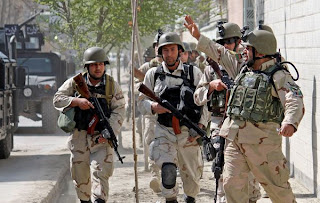The Taliban Claims Responsibility for Multiple Attacks, Announces Beginning of “Spring Offensive.” Depite attempts by the Afghan government, backed by the West, to pursue negotiations with the Taliban, the Taliban has begun what it calls its “Spring Offensive,” aimed at proving that it remains a powerful force to be respected and feared.
The Taliban Claims Responsibility for Multiple Attacks – Locations of the Attacks
The Taliban attacks began in the Afghan capital of Kabul, when Taliban teams took over the Kabul Star Hotel, a luxury hotel built inside a highly secure VIP area in Kabul. The hotel is within firing distance of the embassies of Iran, India, Germany, Turkey, China, Japan,Britain, and France. Also within firing range are the US military’s Camp Eggers and the ISAF headquarters.
Simultaneously, Taliban gunmen snuck inside the Afghan Milli Bank branch near Parliament on the west side of Kabul. There are no reports of casualties, but several members of parliament took up weapons and fired back on the militants from parliament, according to parliamentarian Mohammad Naeem Lalai.A third attack in Kabul took place against NATO’s military base in the eastern part of Kabul, along the road heading east to Jalalabad.
In Jalalabad, at the gate to the city’s airport – where US troops are based – there are reports of a suicide attack. And Taliban gunmen are also reported to have attacked the governor’s house in Pul-e Alam, the capital of Logar Province, which borders Kabul Province to the south. Fighting is also reported in the capital of the southeastern province of Paktia.
In an emailed statement, the Ministry of Interior says its forces identified and intercepted a car carrying explosives. “During the fight a [Toyota van] full of explosives was driving on the Darul Aman road and was recognized by the security personnel and was blown up,” the ministry statement says.
The Taliban Claims Responsibility for Multiple Attacks - Attacks are More Symbolic than Strategic
Reports and analysis indicate that the Taliban attacks are more noise and “bluster” than anything truly significant. “It’s [the attacks] specifically designed for grabbing headlines, without actually carrying out a full out attack on these high profile targets,” says Martine van Bijlert, co-director of the Afghanistan Analysts Network in Kabul. “The key is for them to get into these abandoned buildings that are strategically placed, and start shooting, and create the impression that they are attacking.”
There are reports that several more attackers were intercepted on the way to locations, she adds, but in the meantime, these attacks tend to “close down the city.” For a group like the Taliban, which operates as a guerrilla group, with relatively light weaponry carried by individuals – rifles, rocket propelled grenade launchers, perhaps mortars – the Sunday afternoon attacks are perfectly suited for “giving the impression that Kabul is under attack,” says van Bijlert. “With limited means, you can project something larger than you are actually capable of doing.”
In fact, the Taliban seems to simply be petulantly responding to NATO’S dismissal of it’s strength by staging the coordinated attacks. The Taliban’s main spokesperson, Zabihulla Mujahid, had this to say:
“Some days back the Secretary General of NATO [Anders Fogh Rasmussen] on his visit to Kabul said that the Taliban are not strong enough now,”Zabihullah Mujahid told the Monitor in a phone interview from an undisclosed location. “This was a clear message to him to show how strong we are, and they did not put serious attention to Afghanistan issue.” He says Taliban fighters are equipped with a variety of light and heavy weapons and can attack anywhere they want in the country, and that today’s assault will be followed by a “Spring Offensive.”
“… it appears that the value of the Sunday Taliban attacks is more symbolic than strategic. Afghan security forces appeared to contain the situation without calling in for assistance from the American-led International Security and Assistance Force (ISAF). But by deploying small numbers of fighters to a variety of locations in Kabul’s diplomatic quarter, the Taliban has played to its own strength – of creating a sense of insecurity among the Afghan population, and generating headlines that will embarrass both the Afghan government and its Western backers.”
The Taliban Claims Responsibility for Multiple Attacks – Taliban Succeeds in Creating Fear and Uncertainty
The Taliban may have failed in this attempt to prove its “might” to the world, but it did succeed in creating more fear and uncertainty within Afghanistan locals. Afghans still fear the Taliban, and their hope that the Taliban will be defeated and diminished by Afghan and foreign security forces, has been shaken. Mohammad Rahim, a shopkeeper in Kabul, echoes the sentiments of many in the region:
Mohammad Rahim, a shopkeeper on Kabul’s Butcher Street, says he can’t understand how the Taliban were able to mount such an attack in Kabul itself.
“There is military and police everywhere on the streets of Kabul, they check cars coming to Kabul from provinces, but still these kind of massive attacks happen,” Mr. Rahim says. “It means that even the security people are helping them [the Taliban] or the police personnel are lazy in their jobs.”
He says he has lost faith in the government and foreign forces to bring security in the country.
“Everyone in the leadership is just busy with corruption, foreigners are corrupt too. Just poor people are suffering because of insecurity and poverty,” he says. “See how many poor and those people who work on streets would be killed today? I believe there will be a lot.”


No comments:
Post a Comment